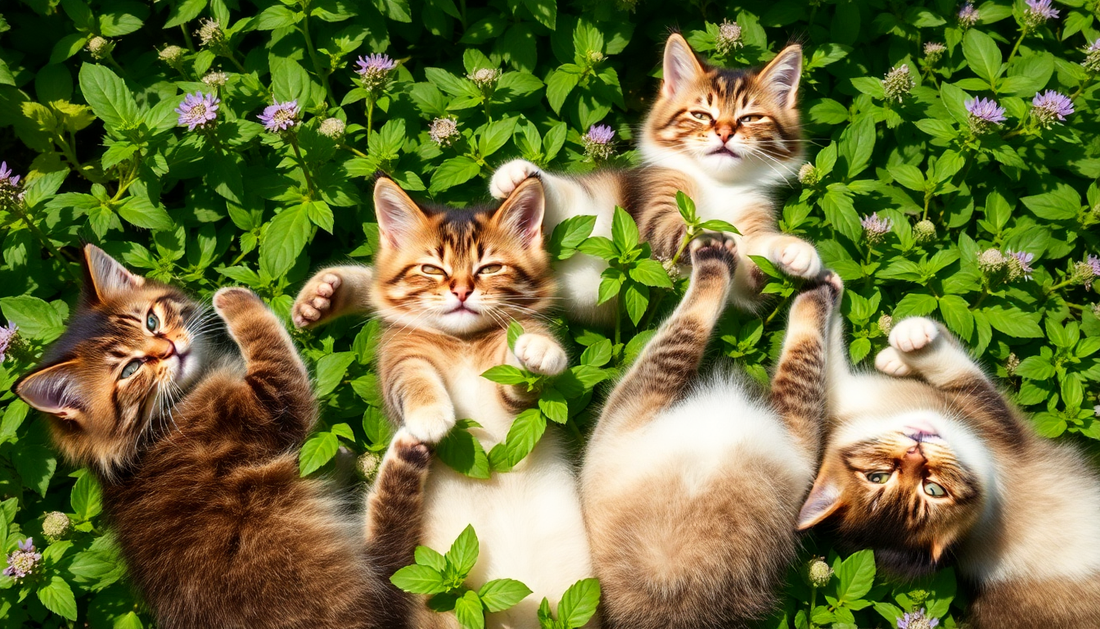
Catnip: The Feline Frenzy Explained
Share
Ah, catnip—the magical herb that sends our feline friends into a frenzy of playful delight. As pet owners, we've all witnessed the captivating scene: our cats sniffing, licking, and rolling around in pure ecstasy when exposed to this mysterious plant. But have you ever wondered what exactly is going on in their furry little heads when they experience the "catnip high"?
The Science Behind the Feline Frenzy
Catnip, scientifically known as Nepeta cataria, is a member of the mint family. The active ingredient responsible for the intoxicating effect is a chemical compound called nepetalactone. When a cat's olfactory system (sense of smell) detects this compound, it triggers a response in the brain that mimics the effects of certain recreational drugs in humans.
The nepetalactone molecules bind to specific receptors in the cat's nasal cavity, which then send signals to the olfactory bulb in the brain. This, in turn, stimulates the release of feel-good neurotransmitters like dopamine and serotonin, creating a euphoric high for the feline.
Interestingly, not all cats are equally affected by catnip. The response is largely determined by genetics, with about 50-70% of cats being susceptible to the herb's charms. Kittens under the age of 3-6 months typically don't show any reaction, as their olfactory receptors haven't fully developed yet.
The Catnip Craze: Behaviors Explained
When a cat experiences the catnip high, the typical behaviors you might observe include:
- Sniffing and licking the catnip
- Head shaking and chin and cheek rubbing
- Rolling around on the ground
- Jumping, pouncing, and batting at the catnip
- Purring, meowing, and chirping
These behaviors are a result of the cat's brain being flooded with feel-good chemicals. The cat is essentially experiencing a temporary state of euphoria, similar to the "high" that humans feel from certain recreational drugs.
The catnip high usually lasts around 5-15 minutes, after which the cat will become temporarily immune to the effects of the herb. This is because the olfactory receptors become desensitized to the nepetalactone. However, after a brief break, the cat will be able to experience the catnip high all over again.
The Many Uses of Catnip
While the catnip craze may seem like just a source of entertainment for our feline friends, the herb has a variety of practical applications in the world of pet care.
Enrichment and Playtime
One of the most common uses of catnip is as a tool for environmental enrichment and playtime. By sprinkling a bit of catnip on a cat's favorite toys or scratching posts, you can encourage them to engage in natural behaviors like scratching, pouncing, and exploring. This helps to keep your cat physically and mentally stimulated, reducing the risk of boredom and destructive behaviors.
Stress Relief and Anxiety Management
Catnip has also been found to have a calming effect on cats, particularly in stressful situations. The euphoric high can help to alleviate anxiety, making it a useful tool for managing conditions like separation anxiety or fear of loud noises, such as thunderstorms or fireworks.
Flea and Tick Repellent
Interestingly, catnip's strong scent not only attracts cats but also acts as a natural insect repellent. The nepetalactone compound in catnip can effectively deter fleas, ticks, and other pests from infesting your feline friend. This makes catnip a valuable addition to your pet's grooming and care routine.
Medicinal Applications
While more research is still needed, some studies have suggested that catnip may have potential medicinal applications. The herb has been found to possess anti-inflammatory, antioxidant, and even anti-cancer properties. This has led to the exploration of using catnip in the development of natural remedies for various health conditions in both humans and animals.
Responsible Catnip Usage
As with any substance, it's important to use catnip responsibly and in moderation. While the herb is generally safe for cats, excessive or improper use can lead to potential issues.
Moderation is Key
Overexposure to catnip can cause your cat to become desensitized to its effects, reducing the enjoyment and benefits they experience. It's best to limit catnip usage to a few times a week, or even just as an occasional treat.
Organic and High-Quality Catnip
When purchasing catnip, be sure to choose organic, high-quality products from reputable sources. Avoid any catnip that may have been treated with pesticides or other chemicals, as these can be harmful to your cat's health.
Supervision and Safety
Always supervise your cat when they are enjoying their catnip experience. While the herb is generally safe, it's important to ensure your cat doesn't accidentally ingest too much or get into any potentially dangerous situations while under the influence.
By understanding the science behind the catnip craze and using it responsibly, you can provide your feline friend with a safe and enjoyable way to indulge in their natural instincts and find a little bit of feline bliss.
Conclusion
Catnip is a truly fascinating and multifaceted herb that has captivated cat owners for generations. From its ability to trigger a euphoric high to its potential medicinal applications, this humble plant continues to surprise and delight us. By embracing the catnip craze and using it responsibly, we can enhance our cats' overall well-being and create even stronger bonds with our furry companions.
So, the next time you see your cat rolling and frolicking in a pile of catnip, take a moment to appreciate the science behind their feline frenzy. It's a truly remarkable and endearing display of our cats' unique relationship with this remarkable herb.
